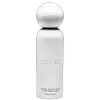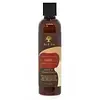What's inside
What's inside
 Key Ingredients
Key Ingredients

No key ingredients
 Benefits
Benefits

 Concerns
Concerns

 Ingredients Side-by-side
Ingredients Side-by-side

Water
Skin ConditioningGlycerin
HumectantCetearyl Alcohol
EmollientHydrogenated Ethylhexyl Olivate
EmollientBehentrimonium Chloride
PreservativeButyrospermum Parkii Butter
Skin ConditioningC12-15 Alkyl Benzoate
AntimicrobialGlyceryl Stearate
EmollientGlycol Stearate
EmollientLactobacillus
Skin ConditioningHydrogenated Olive Oil Unsaponifiables
EmollientHydroxypropyl Bis-Hydroxyethyldimonium Chloride
HumectantPolyquaternium-4
Helianthus Annuus Seed Extract
Skin ConditioningC9-12 Alkane
SolventSqualane
EmollientArgania Spinosa Kernel Oil
EmollientAdansonia Digitata Seed Oil
EmollientNigella Sativa Seed Oil
EmollientCitrullus Lanatus Seed Oil
EmollientMoringa Oleifera Seed Oil
EmollientBoswellia Carterii Oil
MaskingHyssopus Officinalis Extract
MaskingCoco-Caprylate/Caprate
EmollientHydroxyethylcellulose
Emulsion StabilisingHibiscus Rosa-Sinensis Flower Extract
HumectantChlorella Ferment
Skin ConditioningTremella Fuciformis Polysaccharide
Emulsion StabilisingPanthenol
Skin ConditioningOlea Europaea Fruit Oil
MaskingSodium Laneth-40 Maleate/Styrene Sulfonate Copolymer
Parfum
MaskingCaramel
Cosmetic Colorant1,2-Hexanediol
Skin ConditioningEthylhexylglycerin
Skin ConditioningPhenoxyethanol
PreservativePentylene Glycol
Skin ConditioningBenzyl Alcohol
PerfumingPotassium Sorbate
PreservativeDisodium Phosphate
BufferingSodium Phosphate
BufferingPolysorbate 60
EmulsifyingAlcohol
AntimicrobialLinalool
PerfumingLimonene
PerfumingCoumarin
PerfumingCitronellol
PerfumingAlpha-Isomethyl Ionone
PerfumingWater, Glycerin, Cetearyl Alcohol, Hydrogenated Ethylhexyl Olivate, Behentrimonium Chloride, Butyrospermum Parkii Butter, C12-15 Alkyl Benzoate, Glyceryl Stearate, Glycol Stearate, Lactobacillus, Hydrogenated Olive Oil Unsaponifiables, Hydroxypropyl Bis-Hydroxyethyldimonium Chloride, Polyquaternium-4, Helianthus Annuus Seed Extract, C9-12 Alkane, Squalane, Argania Spinosa Kernel Oil, Adansonia Digitata Seed Oil, Nigella Sativa Seed Oil, Citrullus Lanatus Seed Oil, Moringa Oleifera Seed Oil, Boswellia Carterii Oil, Hyssopus Officinalis Extract, Coco-Caprylate/Caprate, Hydroxyethylcellulose, Hibiscus Rosa-Sinensis Flower Extract, Chlorella Ferment, Tremella Fuciformis Polysaccharide, Panthenol, Olea Europaea Fruit Oil, Sodium Laneth-40 Maleate/Styrene Sulfonate Copolymer, Parfum, Caramel, 1,2-Hexanediol, Ethylhexylglycerin, Phenoxyethanol, Pentylene Glycol, Benzyl Alcohol, Potassium Sorbate, Disodium Phosphate, Sodium Phosphate, Polysorbate 60, Alcohol, Linalool, Limonene, Coumarin, Citronellol, Alpha-Isomethyl Ionone
Water
Skin ConditioningCetearyl Alcohol
EmollientCetyl Alcohol
EmollientCocos Nucifera Fruit Extract
EmollientPhyllanthus Emblica Fruit Extract
HumectantBeta Vulgaris Root Extract
Skin ConditioningPhytosterols
Skin ConditioningSerenoa Serrulata Fruit Extract
Skin ConditioningCamellia Sinensis Leaf Extract
AntimicrobialGlycerin
HumectantPyrus Malus Fruit Extract
Skin ConditioningCitrus Limon Peel Extract
EmollientSaccharum Officinarum Extract
MoisturisingBetaine
HumectantBehentrimonium Methosulfate
Stearamidopropyl Dimethylamine
EmulsifyingCitric Acid
BufferingPhenoxyethanol
PreservativeCaprylyl Glycol
EmollientPotassium Sorbate
PreservativePolyacrylamide
Parfum
MaskingAnise Alcohol
PerfumingCoumarin
PerfumingLimonene
PerfumingWater, Cetearyl Alcohol, Cetyl Alcohol, Cocos Nucifera Fruit Extract, Phyllanthus Emblica Fruit Extract, Beta Vulgaris Root Extract, Phytosterols, Serenoa Serrulata Fruit Extract, Camellia Sinensis Leaf Extract, Glycerin, Pyrus Malus Fruit Extract, Citrus Limon Peel Extract, Saccharum Officinarum Extract, Betaine, Behentrimonium Methosulfate, Stearamidopropyl Dimethylamine, Citric Acid, Phenoxyethanol, Caprylyl Glycol, Potassium Sorbate, Polyacrylamide, Parfum, Anise Alcohol, Coumarin, Limonene
 Reviews
Reviews

Ingredients Explained
These ingredients are found in both products.
Ingredients higher up in an ingredient list are typically present in a larger amount.
Cetearyl alcohol is a mixture of two fatty alcohols: cetyl alcohol and stearyl alcohol. It is mainly used as an emulsifier. Emulsifiers help prevent the separation of oils and products. Due to its composition, it can also be used to thicken a product or help create foam.
Cetearyl alcohol is an emollient. Emollients help soothe and hydrate the skin by trapping moisture.
Studies show Cetearyl alcohol is non-toxic and non-irritating. The FDA allows products labeled "alcohol-free" to have fatty alcohols.
This ingredient is usually derived from plant oils such as palm, vegetable, or coconut oils. There is debate on whether this ingredient will cause acne.
Due to the fatty acid base, this ingredient may not be Malassezia folliculitis safe.
Learn more about Cetearyl AlcoholCoumarins are a group of substances found naturally in plants. There are over 1300 types of coumarins identified. It has a natural vanilla scent.
Coumarin is an identified EU known allergy, meaning it may cause an allergic reaction when applied to the skin.
In many countries, coumarin is banned as a food additive. However, it can be found in soaps, tobacco products, and some alcohol drinks.
Plants use coumarins as a chemical defense. Some plants that have coumarins include lavender, tonka beans, and yellow clovers.
Learn more about CoumarinGlycerin is already naturally found in your skin. It helps moisturize and protect your skin.
A study from 2016 found glycerin to be more effective as a humectant than AHAs and hyaluronic acid.
As a humectant, it helps the skin stay hydrated by pulling moisture to your skin. The low molecular weight of glycerin allows it to pull moisture into the deeper layers of your skin.
Hydrated skin improves your skin barrier; Your skin barrier helps protect against irritants and bacteria.
Glycerin has also been found to have antimicrobial and antiviral properties. Due to these properties, glycerin is often used in wound and burn treatments.
In cosmetics, glycerin is usually derived from plants such as soybean or palm. However, it can also be sourced from animals, such as tallow or animal fat.
This ingredient is organic, colorless, odorless, and non-toxic.
Glycerin is the name for this ingredient in American English. British English uses Glycerol/Glycerine.
Learn more about GlycerinLimonene is a fragrance that adds scent and taste to a formulation.
It's found in the peel oil of citrus fruits and other plants such as lavender and eucalyptus. The scent of limonene is generally described as "sweet citrus".
Limonene acts as an antioxidant, meaning it helps neutralize free radicals.
When exposed to air, oxidized limonene may sensitize the skin. Because of this, limonene is often avoided by people with sensitive skin.
The term 'fragrance' is not regulated in many countries. In many cases, it is up to the brand to define this term. For instance, many brands choose to label themselves as "fragrance-free" because they are not using synthetic fragrances. However, their products may still contain ingredients such as essential oils that are considered a fragrance.
Learn more about LimoneneParfum is a catch-all term for an ingredient or more that is used to give a scent to products.
Also called "fragrance", this ingredient can be a blend of hundreds of chemicals or plant oils. This means every product with "fragrance" or "parfum" in the ingredients list is a different mixture.
For instance, Habanolide is a proprietary trade name for a specific aroma chemical. When used as a fragrance ingredient in cosmetics, most aroma chemicals fall under the broad labeling category of “FRAGRANCE” or “PARFUM” according to EU and US regulations.
The term 'parfum' or 'fragrance' is not regulated in many countries. In many cases, it is up to the brand to define this term.
For instance, many brands choose to label themselves as "fragrance-free" because they are not using synthetic fragrances. However, their products may still contain ingredients such as essential oils that are considered a fragrance by INCI standards.
One example is Calendula flower extract. Calendula is an essential oil that still imparts a scent or 'fragrance'.
Depending on the blend, the ingredients in the mixture can cause allergies and sensitivities on the skin. Some ingredients that are known EU allergens include linalool and citronellol.
Parfum can also be used to mask or cover an unpleasant scent.
The bottom line is: not all fragrances/parfum/ingredients are created equally. If you are worried about fragrances, we recommend taking a closer look at an ingredient. And of course, we always recommend speaking with a professional.
Learn more about ParfumPhenoxyethanol is a preservative that has germicide, antimicrobial, and aromatic properties. Studies show that phenoxyethanol can prevent microbial growth. By itself, it has a scent that is similar to that of a rose.
It's often used in formulations along with Caprylyl Glycol to preserve the shelf life of products.
Potassium Sorbate is a preservative used to prevent yeast and mold in products. It is commonly found in both cosmetic and food products.
This ingredient comes from potassium salt derived from sorbic acid. Sorbic acid is a natural antibiotic and effective against fungus.
Both potassium sorbate and sorbic acid can be found in baked goods, cheeses, dried meats, dried fruit, ice cream, pickles, wine, yogurt, and more.
You'll often find this ingredient used with other preservatives.
Learn more about Potassium SorbateWater. It's the most common cosmetic ingredient of all. You'll usually see it at the top of ingredient lists, meaning that it makes up the largest part of the product.
So why is it so popular? Water most often acts as a solvent - this means that it helps dissolve other ingredients into the formulation.
You'll also recognize water as that liquid we all need to stay alive. If you see this, drink a glass of water. Stay hydrated!
Learn more about Water